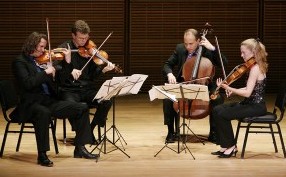
Head and Heart Come Together in St. Lawrence String Quartet

|
Chamber Music Cincinnati joined hands with the new Constella Festival of Music and Fine Arts to present the St. Lawrence String Quartet Tuesday evening (Oct. 18) in Robert J. Werner Recital Hall at the University of Cincinnati College-Conservatory of Music.
There could have been no better choice for the collaboration since the Quartet is one of the brightest on the scene today and they brought an exceptional program of 18th to 21st century works with them.
First of all, there is no quartet like the St. Lawrence. (Violinists Geoff Nuttall and Scott St, John, violist Lesley Robertson and cellist Christopher Costanza are ensemble-in-residence at Stanford University). Extremely communicative, they play with an uncanny combination of informed musicality and pure emotion. One does not intrude upon the other. And making it even more rewarding, they seem to enjoy what they are doing. Nuttall, first violinist and spokesman for the group, could be a one-man ambassador for the joy of chamber music, so enthusiastic was his advocacy, both through the notes on the page and his comments from the stage.
The substance of what the SLSQ does was very much in evidence in Mozart’s great Quartet in D Minor, K. 421, which opened the concert. Never has this writer heard the opening statement of the first movement shaped so expressively. Using vibrato selectively, Nuttall shaped it into a cry of despondency (D Minor had such connotations for the composer). Yet nothing interfered with the ensemble’s pinpoint reading of the score. In the Menuetto, they conveyed passion as well as fun (as in the Trio, with its saucy clipped theme), and the variations in the finale were likewise deeply felt.
Nuttall introduced Erich Wolfgang Korngold’s String Quartet No. 3 in D Major, pointing out its incorporation of themes from Korngold’s Hollywood film scores (and the coincidence of have two composers on one concert with the name Wolfgang). In fact, Korngold’s Quartet No. 3 (1944-1945) was his “return” to classical composition after several years penning Academy Award-winning film music in Hollywood. It was an ear-opening performance. The opening Allegro moderato was angst-ridden, comfortably late romantic, with a slurpy cello theme and a gentle ending. The melodious Trio of the Scherzo is based on a theme from the composer’s favorite film score, “Between Two Worlds.” The slow movement references the love theme from “The Sea Wolf,” its muted theme growing in intensity before ending on a soft high note by Nuttall. There was a triumphal quality about the Finale, as if having just arrived somewhere, bringing the work to an upbeat ending.
American composer John Adams wrote his String Quartet (2008) for the SLSQ. (Nuttall provided an engaging introduction to it, as well as the Korngold.) In two unequal movements (the first much longer than the second), it was full spectrum Adams, with everything from pulsing minimalism to intricate rhythmic interplay, always with a “beat” or ostinato somewhere. It was fun to watch the Quartet “groove” to the music, exchanging smiles and gestures. Nuttall himself rose frequently from his chair or otherwise matched his body rhythm to the music.
The first movement began in minimalist fashion, with rustling upper strings over pizzicato cello. In four parts, it is effectively a quartet-within-a-quartet, with a slower, muted section and much fragmentary development, before ending slowly and quietly. The Second movement opened with bouncing octaves in the first violin and cello, another nod to Adams’ minimalist past. The music grew muscular, even frantic as it approached its strenuous end. Nuttall mopped his brow as the foursome took a bow.
The encore was a literally “swinging” Minuet from Haydn’s Quartet Op, 74, No. 1.